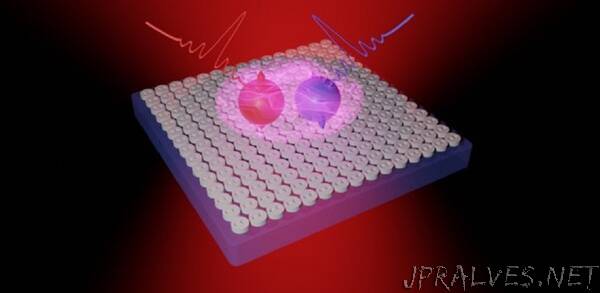
“A new method for generating quantum-entangled photon pairs employs nonlinear metasurfaces to enhance and tailor photon emissions—an important step towards creating miniaturized quantum devices for everyday applications
Quantum nanophotonics is an active research field with emerging applications that range from quantum computing to imaging and telecommunications. This has motivated scientists and engineers to develop sources for entangled photons that can be integrated into nano-scale photonic circuits. Practical application of nanoscale devices requires a high photon-pair generation rate, room-temperature operation, and entangled photons emitted at telecommunications wavelengths in a directional manner.
The most common way to create entangled photons is by a process known as Spontaneous Parametric Down Conversion (SPDC) which involves a single photon being split into two entangled photons of lower frequencies, known as the signal and idler. Conventional approaches for SPDC rely on bulky devices that are up to several centimeters in length and are not optimal for photonic circuit integration. Conversely, at the nanoscale, the efficiency of the SPDC process is hindered by the small volume of the resonators, and the directionality of the emitted photons is challenging to control.
Dielectric metasurfaces offer a promising route to enhance and tailor SPDC photon emission. To date, however, metasurfaces have used relatively low quality-factor Mie resonances and have an accordingly broad emission spectrum, which restricts the spectral brightness of photons. New research reveals that extended Bound States in the Continuum (BIC) resonances make it possible to harness modes in the metasurface that have very high quality factors. This in turn means that the photon-pair generation inside the resonators is enhanced by many orders of magnitude and the wavelength of the photons will have a very narrow bandwidth. This results in a very high spectral brightness, which is beneficial for quantum network applications.
As reported in Advanced Photonics, an international team of researchers from the Australian National University (Matthew Parry, Dragomir N. Neshev, and Andrey A. Sukhorukov), Politecnico di Milano (Andrea Mazzanti and Giuseppe Della Valle) and ITMO University of St. Petersburg (Alexander Poddubny) recently demonstrated enhanced generation of nondegenerate photon pairs in nonlinear metasurfaces. In a series of comprehensive simulations, they used separate BICs at slightly different wavelengths for the signal and idler photons in SPDC, which enabled them to enhance the brightness of entangled photons by five orders of magnitude over that of an unpatterned thin film of nonlinear material. They attribute this enhancement largely to the novel phenomenon of hyperbolic transverse phase matching, which facilitates efficient photon generation across a broad range of photon momentums.
Not only does their proposed method enable the generation of photon pairs that are quantum-entangled, but by simply changing the linear polarization of the pump laser it is possible to tune the polarization entanglement of the photons from full to none. This is an easily implemented way to control the entanglement, so that it meets the requirements of prospective applications. The proposed platform is also highly configurable with respect to both the wavelength of the signal and idler photons as well as the BICs used, which opens up the potential for engineering the direction in which photons are emitted.
The researchers, whose work is supported by the Australian Research Council and by the European Commission’s Horizon 2020 program, say that their advance is an important step towards miniaturized quantum devices for everyday applications.
Read the open access report by Parry et al.: “Enhanced generation of nondegenerate photon pairs in nonlinear metasurfaces,” Adv. Photon. 3(5) 055001 (2021) doi 10.1117/1.AP.3.5.055001.”
